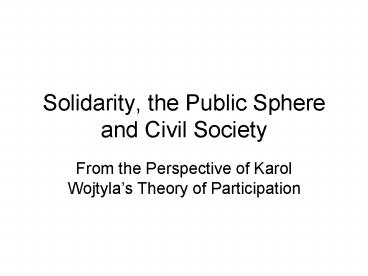Solidarity, the Public Sphere and Civil Society - PowerPoint PPT Presentation
1 / 15
Title:
Solidarity, the Public Sphere and Civil Society
Description:
In his encyclical Letter Solicitudo Rei Socialis, Pope JPII refers to solidarity ... 'not a feeling of vague compassion or shallow distress at the misfortunes of so ... – PowerPoint PPT presentation
Number of Views:82
Avg rating:3.0/5.0
Title: Solidarity, the Public Sphere and Civil Society
1
Solidarity, the Public Sphere and Civil Society
- From the Perspective of Karol Wojtylas Theory of
Participation
2
in solidum obligare
- Roman legal tradition
- of exacting a collective obligation
3
In his encyclical Letter Solicitudo Rei Socialis,
Pope JPII refers to solidarity as a virtue,
- not a feeling of vague compassion or shallow
distress at the misfortunes of so many people,
both near and far. On the contrary, it is a firm
and persevering determination to commit oneself
to the common good that is to say to the good of
all and of each individual, because we are all
really responsible for all (p OSC 71).
4
Hannah Arendt on Solidarity
- the capacity to suffer with the immense class
of the poor, accompanied by the will to raise
compassion to the rank of the supreme political
passion and of the highest political virtue. (OR
75).
5
For Karol Wojtyla,
- Solidarity means the continuous readiness to
accept and perform that part of a task which is
imposed due to ones participation as member of
a specific community (TPP 47).
6
Solidarity and opposition
- Oppositionists are merely searching for
participation and such a definition of the common
good that would permit them to participate more
fully and effectively in the community.
(WojtylaTPP ) - (kaaway, kabangga, kalaban, katalo, etc).
7
Wojtyla on Alienation
- The root of alienation of human beings by human
beings is contained in the subject, lack of
closeness, and the relevant assimilation of
people in humanity as the basic community. (TPP
56)
8
The Public Sphere
- Ancient Greek distinction between
- Oikos and Polis
9
Contemporary public spheres
- communications and information technologies are
providing new opportunities for new forms of
public spheres. - Video, fax and cellular phones
10
Civil Society
- organizes the citizenry to assert itself in
pushing for land reform, health, environmental
protection and the solution to other problems
which weigh heavily on the people (Carrol)
11
Dual function of civil society
- transforming political and economic systems on
the one hand, - and of poverty alleviation and peoples
empowerment, on the other hand. - Their solidarity with the aspirations of the
marginalized sectors, after all, is the
inspiration that fuels the dynamism of the
members of civil society.
12
Participation from the margins to the center
- Unlike Solidary social movements that move from
the center to the periphery, or of Civil society
that mediates the interests of the mainstream
sectors and that of the marginalized, the tide of
participation moves from the margins towards the
center
13
Arendt, Hegel and Wojtyla converge on the
politics of recognition
- Hannah Arendt (whom you will encounter
tomorrow) once remarked that darkness rather
than want is the curse of poverty (OR 69).
Human self-consciousness, Hegel likewise says,
exists only in being acknowledged. (PS 111).
Karol Wojtyla rejoins Arendt and Hegel when he
defines participation in terms of turning toward
another self on the basis of personal
transcendence, toward the fullness of truth of
this other person, toward humanity, one might
say (TPP 28) Participation confirms the
self and permits the individual to unfold. (29).
14
Wojtylas norm for human development
- It is mandatory that in structuring human
coexistence and cooperation on various levels and
on the basis of a variety of ties that determine
communities and societies the system of
relationships identified as closeness be the
final determinant. (56)
15
(No Transcript)































